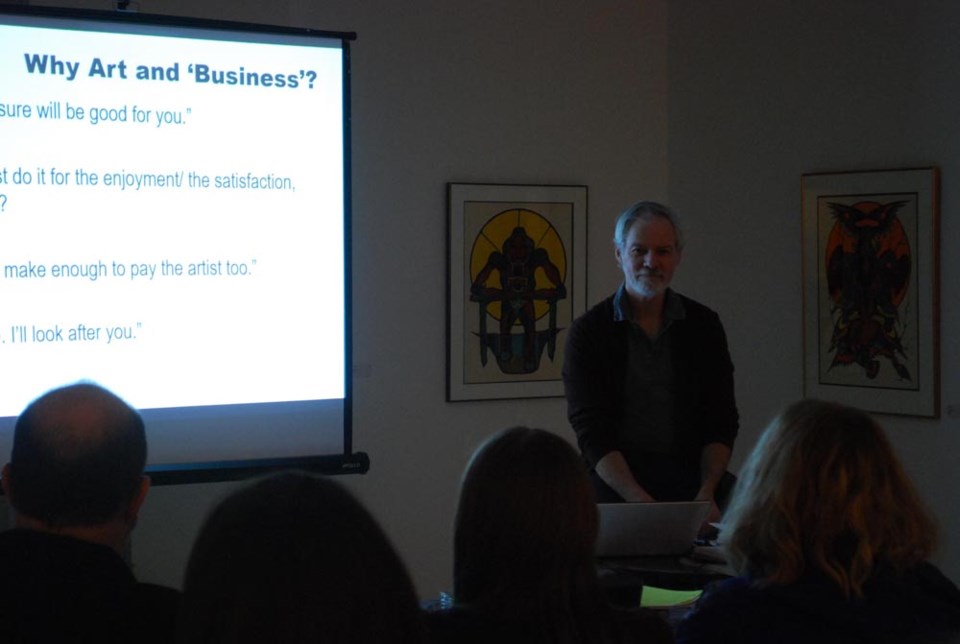If an artist wants to take their art to the next step, learning about the business side of art is an important step to becoming a professional artist.
This is the reason Grant McConnell with Canadian Artists’ Representation/Le Front des artistes canadiensz, also known as CARFAC, and is a lecturer at St. Peter’s College and the University of Saskatchewan came to speak to fellow artists about becoming business people on Feb. 3 at the Humboldt Gallery.
McConnell himself is a working artist, someone who is dedicated to critical art making, which is destined for exhibition, says McConnell.
“For me, a professional artist is tied into that, too. For myself personally, I have an expectation that a significant portion of my livelihood is derived from the making of art.”
The room was full of local artists ranging in age from high school to retirement age.
This says a lot about the attitude of artists in Saskatchewan.
“As artists, we take pleasure in what it is that we do but to have an expectation that you‘d take it seriously and something that would create a portion of a living is very important.”
To learn about the business side of their craft is very important, says McConnell, whether the artist is a musician, dancer, or painter. This is the best way to support yourself as an artist, says McConnell, who joked at the beginning of the presentation that this was all the information he wished he would have gotten when he started his art career.
“It’s great to have the artist right at the beginning of their trajectory of their careers.”
Canadian Artists’ Representation is just one part of the artistic community that can benefit an artist. Artists themselves need to go out and either look for more resources, either through educators or other artists.
This can really extend their career, says McConnell.
“It means you’re building a more professional practice, you’re giving yourself a better chance as an artist to be successful in getting your good work out into the larger world.”
Canadian Artists’ Representation offers 25 different workshops on what to do as professional artists and getting this advise is important for any artist at any stage of their career.
Though Canadian Artists’ Representation is focused on visual artists, the need for artist to professionalize crosses disciplines.
Some disciplines have more success but the needs and challenges are very similar, says McConnell.
“It’s important that our fellow disciplines get a leg up to understanding how to better be recompensed for what it is our fellow professionals are doing in the arts.”
Being a professional artist is not for everybody, says McConnell but it does not cheapen the industry by having someone say they want to make a living on their art or by someone saying they just want to do it for the pleasure of it. The business side of it is something they have to take very seriously if they do decide to sell their work.
McConnell discussed a variety of different challenges when it comes to becoming a professional artist; from developing a portfolio of their work to copyright protection to what to charge for a gallery or museum to put their work on display.
Canadian Artists’ Representation does have a fee schedule on their website that shows the minimum of what an artist should be paid to continue their work, whether it be with a commercial gallery that is going to sell their work or a public gallery that is just going to show their work as part of an exhibit.
McConnell says they have been working on the schedule for the last 45 years to keep it current by talking with galleries themselves that pay the fees, as well as numerous associations that deal with artists and galleries first hand.
The fees listed are a minimum paid fee so they are negotiable between the artist and everyone from the company that wants to reproduce their work for a report cover to the commercial gallery that wants to sell their work and takes a portion of the profits.
The artist can use the schedule as a guideline.
“We think we’re being very reasonable in asking a reasonable minimum for what we do as artists.” Says McConnell.
Knowing their work is also an important part of business for the artist.
Just as their work can be on an evocative; draws people in, to provocative; controversial, scale, a gallery can lie somewhere on that scale as well, they have to know where their art will fit.
For copyrighting, as soon as the artist finishes their piece, it is their legal work without having to register or create a copyright, says McConnell.
Canadian Artists’ Representation has many resources when it comes to questions of copyright, seeking legal advice, or tips on protecting the artist, along with many other resources, like grant information and creating an artist profile.
For more information on becoming a professional artist, visit www.carfac.ca.




